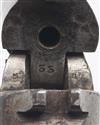Product Details
HAVILAND & GUNN, USA
AN EXCEPTIONALLY RARE .21 BREAK-BARREL AIR-RIFLE, MODEL '1880 TYPE', serial no. 33,
made 1880-81, with brass lined half octagonal, half round 17in. barrel, fixed open sights, dolls-head locking catch to top of breech (hairline crack at breech hinge), the breech face stamped with a small 'H' and 'G', slanting nickel-plated air-chamber marked 'Y.PAT.APR. 18 1871', walnut butt-stock (crack to one side at head, the left hand side with 'WATSON 4 PALL MALL LONDON' retailer's stamp, iron crescent heel-plate and trigger-guard acting as the cocking link
Provenance: George Gunn could possibly be called the father of the modern spring air-gun despite the fact that most have never heard of him. Patent No. 113766 of April 18th 1871 introduced the concept of using a barrel to cock a spring-operated air-rifle and a year later Patent no. 126954 of May 21st 1872 covered the idea of housing the spring in the grip. Between these two patents the majority of spring operated air-rifle designs (and air pistols) were covered.
In fairness, both patents were accredited to Benjamin Haviland as well. Haviland became Gunn's business partner in 1871 at about the time Gunn's first patent was filed, although his input would appear to be more sales and marketing as opposed to technical. Their initial product was quite unique in that it had a removable barrel liner and an aperture for a floating firing pin on the breech-face allowing it to operate as an air-rifle or a conventional cartridge rifle. The improved model introduced in 1880 continued with this concept, but a few were built as just rifles and a further few as just air-rifles, as here. Expert opinion currently suggests that there are seven of these Haviland & Gunn air-rifles in existence making it one of the rarest production air-rifles in existence. This example also bears the stamp of Watson Bros Gunmakers of London, meaning it is one of the tiny number of exported pieces.
One of the big problems faced by Haviland & Gunn was cost. Their premises was little better than a cottage industry situated in Ilion, New York, literally just down the road from the firearms giant Remington. The Haviland & Gunn air-rifle sold for around $20, a phenomenal amount when one considers you could by a basic Winchester lever action rifle for around $4.50, and that there were single-shot small-bore rifles available for less than $1! As you might expect, sales were not strong, and in 1884 the majority of the patents and designs were sold to Quackenbush who also took on Gunn as an employee. Redesigned again, the rifle became the Quackenbush Model 5, a rifle most serious collectors aspire to own. Whilst working for Quackenbush, Gunn designed a repeating version of the Model '5', but it would appear to only exist in Patent no. 337395 of March 9th 1886. The fact that Quackenbush's name does not appear on the patent may have something to do with Gunn leaving his employ the same year; although Quackenbush's diary suggested it was ill health; but whatever the reason, Gunn started a new company called The Atlas Gun Co. with another air-rifle of his own invention, this time a BB gun. He suffered a sad fate when he was hit by a train whilst walking home from work in 1906 aged 79 and the Atlas Gun Co was subsequently sold to the future airgun giant, Daisy.
Please click HERE to view Terms & Conditions.
Estimate £500-700
Pre-1939







